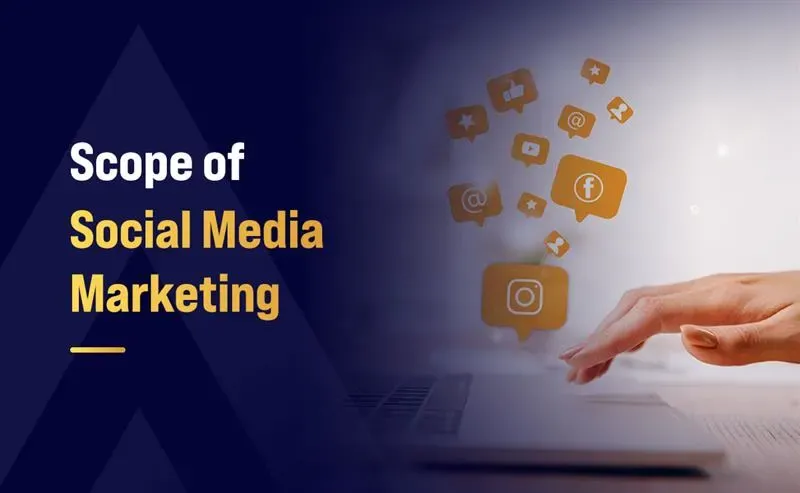The Scope of Social Media Marketing in 2025

The digital revolution of social media has fundamentally transformed how humanity connects, exchanges ideas, and engages in commerce. From connecting with friends to promoting brands, its impact is undeniable. But what exactly is the scope of social media marketing, and why is it such a game-changer for businesses and professionals alike?
In this article, we’ll explore the ins and outs of social media marketing, its benefits, challenges, and future trends, all while keeping it student-friendly and easy to understand.
What is Social Media Marketing (SMM)?

SMM leverages popular platforms such as Facebook, Instagram, Twitter, LinkedIn, and TikTok to market products and services. Rather than simply broadcasting content, it's a calculated method to foster audience engagement, cultivate connections, and spark meaningful exchanges
Think of it as a two-way street: brands share content, and audiences respond through likes, comments, shares, and purchases. Through these exchanges, companies can establish credibility, collect valuable customer input, and expand their customer reach.
Whether it’s a small startup or a global corporation, social media marketing has become an essential part of any digital marketing strategy.
Benefits of Social Media Marketing
Here are six key benefits that make social media marketing a must for any brand:
Boost Brand Awareness and Trust
Social media platforms are home to billions of active users, making them ideal for increasing brand visibility. By sharing authentic content like behind-the-scenes glimpses, customer stories, or employee highlights, you can humanize your brand and build trust.
For example, if a brand commits to environmental activism, it strengthens their credibility and loyalty among customers. When brands showcase genuine character and embrace values that their customers cherish, they distinguish themselves in the marketplace.
Enhance Customer Engagement
Unlike one-way traditional advertising channels, social platforms enable direct dialogue. Companies can instantly engage with comments, amplify customer content, and resolve issues on the spot.
Such dynamic interaction helps create strong community bonds and devoted followers. Whether it’s through witty replies, heartfelt messages, or interactive polls, engaging with your audience shows that your brand cares.
Drive Sales and Conversions
Social media isn’t just about likes and shares; it’s a powerful tool for driving sales. Shoppable posts and targeted advertising allow businesses to create direct pathways to their offerings.
For example, Facebook's remarketing tools can remind shoppers about items they've browsed but haven't purchased, potentially boosting sales completion. This streamlined purchasing journey can dramatically improve conversion statistics.
Gain Valuable Customer Insights
Social platforms offer rich insights into audience preferences, habits, and challenges. By examining metrics such as engagement levels, content sharing, and comment patterns, you can adapt your approach to better serve customer needs.
Social listening, which is monitoring conversations about your brand, can also help you stay ahead of trends and address issues before they escalate.
Build Thought Leadership
Social media gives your brand a voice. By sharing insightful content, taking a stand on important issues, or showcasing your expertise, you can position your company as a thought leader in your industry.
This not only fosters trust but also cultivates a dedicated and loyal audience. For example, brands that address topics like climate change or social justice often resonate deeply with their audience.
Cost-Effective Marketing with High ROI
Among various marketing channels, social media is recognized as one of the most cost-effective tools for promotion. While organic content costs nothing, even paid promotions typically offer better value than conventional advertising. Strategic implementation can yield impressive ROI by connecting with specific audience segments without excessive spending.
Scopes of Social Media Marketing
Here are six key natures and scopes of social media marketing in India:
Influencer Marketing and Brand Partnerships
Collaborating with influencers is a powerful way to expand reach and build credibility. Social media personalities, particularly on Instagram and YouTube, command devoted audiences who value their endorsements. Strategic influencer partnerships enable brands to naturally showcase their products while reaching fresh audience segments.
Social Commerce and Seamless Experiences
Modern social platforms increasingly feature built-in shopping capabilities, enabling direct purchasing from content and advertisements. Platforms such as Instagram and Facebook have introduced built-in product displays and shopping functionalities, simplifying the purchasing process directly within the app, thereby transforming how businesses drive sales.
Crisis Management and Public Relations
When managing public image and communication, social media serves as an essential PR instrument. Platforms like Twitter and Facebook allow brands to provide real-time updates, address concerns, and control the narrative. Quick, honest communication during challenges can transform potential reputation threats into opportunities for strengthening customer relationships.
Localized and Global Reach
Through social platforms, companies can effectively maintain both local presence and worldwide reach. Geo-targeting features on platforms like Instagram and Facebook enable businesses to run hyperlocal marketing campaigns, making it easier to connect with local communities or expand into international markets.
Corporate Social Responsibility (CSR) and Advocacy

Consumers increasingly expect brands to take a stand on social and environmental issues. Social media provides a platform to showcase CSR initiatives, such as sustainability efforts or community support. Authentic advocacy can resonate deeply with audiences, building long-term loyalty.
Retargeting and Re-engaging Lost Customers
Marketing teams can use social platform advertising to reconnect with prospects who expressed interest but didn't complete their purchase. For example, Facebook’s Meta Pixel helps track user behavior, allowing brands to show personalized ads to potential customers, encouraging them to return and convert.
Disadvantages of Social Media Marketing
Here are six key disadvantages of social media marketing that businesses, especially small or new ones, should be aware of:
Not Built for Business Intent
Social media platforms were originally designed for personal connections, not business transactions. People typically use platforms like Facebook or Instagram to relax, chat with friends, or watch videos—not to shop. This lack of "buying intent" makes it harder for businesses to convert social media users into customers compared to platforms like Google or Amazon.
Risk of Negative Feedback
Being active on social media means opening your brand to public scrutiny. Negative comments, reviews, or even trolls can quickly damage your reputation. For new or lesser-known businesses, this risk is even higher, as they lack the established credibility to counteract such feedback.
Heavy Reliance on Paid Ads
Organic reach on social media has significantly declined over the years. Platforms like Facebook and Instagram now prioritize paid ads, making it difficult for businesses to gain visibility without investing heavily in advertising. For small businesses with limited budgets, this can be a major hurdle.
Time-Consuming and Demanding
Social media marketing requires constant effort. From creating content to engaging with followers and staying updated with trends, it demands a significant amount of time and resources. Furthermore, irregular platform activity risks can lead to a diminishing follower base and may reduce your engagement levels
Difficult to Measure ROI
Measuring social campaign effectiveness presents unique challenges. Traditional engagement metrics don't always correlate with business outcomes like revenue or qualified leads. This complexity makes it difficult to calculate precise campaign ROI.
Security and Privacy Concerns
Social media platforms are frequent targets for data breaches and hacking attempts. When you use these platforms for marketing, you’re required to share sensitive business and customer data, which can be compromised. This raises concerns about privacy and security.
Integrating Social Media with Digital Marketing
Social media has become an indispensable part of digital marketing, offering businesses interactive platforms to connect, engage, and convert their target audience. Here’s how social media positions itself within the larger digital marketing landscape.
Seamlessly Integrates with Other Digital Channels
A well-rounded digital marketing strategy incorporates multiple channels, and social media acts as a connecting thread between them. For instance:
- Email marketing: Social media can help grow email lists through lead generation campaigns.
- Paid advertising: Retargeting users from social media ads to websites enhances conversion rates.
- Influencer marketing: Social media influencers amplify brand reach and credibility.
Complementing Content Marketing
Social media is an ideal platform to distribute and promote content, such as blog posts, videos, infographics, and eBooks. By sharing content on social platforms, businesses can increase their reach and engagement while also driving traffic back to their website.
The combined power of social and content marketing ensures your messages resonate with target audiences while advancing overall marketing objectives.
Strengthening Paid Advertising Efforts
Social media advertising complements other paid channels like Google Ads by offering advanced targeting options and cost-effective solutions. For instance, retargeting ads on Facebook can remind users of products they viewed on your website, increasing the likelihood of conversions. This integration ensures that your paid advertising efforts are cohesive and impactful across all platforms.
Enhancing Customer Support and Retention
Social media platforms are increasingly being used for customer support, allowing businesses to address queries, resolve issues, and gather feedback in real time. By connecting with CRM platforms, businesses can effectively monitor and manage customer interactions, leading to improved satisfaction and retention.
Facilitating Cross-Channel Campaigns
Social media plays a key role in cross-channel marketing campaigns. For example, a product launch campaign might include social media teasers, email announcements, and paid ads on Google and Facebook. This comprehensive strategy ensures message delivery across multiple channels, enhancing engagement and conversion potential.
Different Types of Social Media Marketing
The field of social media marketing offers businesses diverse opportunities to engage audiences, enhance brand recognition, and achieve measurable outcomes. Here are the most common types of social media marketing, each with its unique approach and benefits:
Paid Advertising
Paid social media advertising involves running sponsored posts or ads to reach a larger or more targeted audience. Platforms like Facebook, Instagram, LinkedIn, and Twitter offer various ad formats, including:
- Image Ads: Simple visuals with a call-to-action (CTA).
- Video Promotions: Compelling motion content that highlights products or services.
- Multi-Image Ads: Sequential visuals or videos presented in a single promotional unit.
- Creator Partnerships: Strategic relationships with influencers for brand promotion.
Influencer Marketing
The practice of influencer marketing harnesses social media personalities' reach and authority to promote brands. These influencers range from major celebrities with vast followings to niche experts with smaller but highly engaged communities.
This type of social media marketing helps build trust, expand reach, and tap into new audiences through authentic endorsements.
Video Marketing
Video marketing focuses on producing and sharing video content to highlight a brand, product, or service, making it particularly impactful on platforms like YouTube, Instagram, TikTok, and Facebook. The goal is to capture attention, convey messages effectively, and increase engagement.
User-Generated Content (UGC)
User-generated content strategies involve motivating customers to produce and distribute brand-related content. It builds authenticity, trust, and engagement through customer-driven content. This can include:
- Customer Reviews: Sharing testimonials or reviews on social media.
- Photo Contests: Asking users to post photos using your product with a branded hashtag.
- Challenges: Creating viral challenges that encourage participation.
Social Commerce
The integration of shopping features within social platforms enables in-app purchasing capabilities. Examples include:
- Shoppable Posts: Instagram and Facebook posts with product tags.
- Live Shopping: Hosting live streams where viewers can buy products in real time.
- Marketplace Listings: Selling products on platforms like Facebook Marketplace.
Successful Social Media Marketing Examples
Dove’s “Real Beauty Sketches” Campaign
Dove created an innovative campaign called "Real Beauty Sketches" where women provided self-descriptions to a forensic artist. The artist created two sketches: one based on the woman’s self-description, and another based on how others described her.
The artist's second drawing, based on others' descriptions, consistently showed more positive features, revealing self-perception disparities.
Execution:
- The initiative debuted on YouTube before spreading across other major social networks.
- Dove used emotional storytelling and beautiful visuals to resonate with its audience.
- The campaign encouraged women to see their true beauty and share their experiences online.
Results:
- The 3-minute video went viral, garnering 30.6 million views in just two weeks.
- It received 97.6% positive feedback on YouTube, with 98,000 likes and only 2,200 dislikes.
- The campaign generated 660,000 Facebook shares within the first ten days.
GoPro’s “Million Dollar Challenge” Campaign
The "Million Dollar Challenge" by GoPro invited customers to submit footage captured using their cameras. The best clips were compiled into a highlight reel, and the creators shared a $1 million prize.
Execution:
- The brand leveraged its social media presence across major platforms to promote the initiative.
- The brand encouraged users to share their adventurous experiences using the hashtag #GoProMillionDollarChallenge.
- Through authentic user experiences, the campaign demonstrated the capabilities and quality of GoPro products.
Results:
- The campaign received 43,000 video submissions from users worldwide.
- The final highlight reel featured 55 creators from 21 countries, each receiving $18,181.81.
- The campaign significantly boosted GoPro’s social media engagement and strengthened its community of loyal users.
How to Start a Career in Social Media Marketing?
Building a social media marketing career requires combining technical expertise, hands-on experience, and professional connections. Here’s a guide to help you get started:
Learn Essential Skills
Begin by mastering key social media platforms like Facebook, Instagram, Twitter, and LinkedIn. Learn platform-specific content strategies and trending topics. Master analytics tools like Hootsuite, SproutSocial, and HubSpot for performance tracking and data analysis.
Additionally, hone your content creation skills, including writing, graphic design, and video editing, as these are crucial for creating engaging posts.
Gain Practical Experience
Look for entry-level opportunities such as internships, freelance gigs, or volunteer work. Positions like social media coordinator, marketing intern, or social media specialist serve as excellent entry points into the field.
If formal opportunities are scarce, create your own social media pages to experiment with content, analyze performance, and build a portfolio. Freelance marketplaces offer opportunities to gain independent work experience.
Build Your Network
Networking is key to finding opportunities and learning from professionals in the field. Connect with peers, join LinkedIn or Facebook groups for social media marketers, and attend industry events. Professional connections provide crucial industry insights, career opportunities, and guidance for professional development.
Summing Up
Social media marketing has transformed the way businesses connect with their audiences, offering unparalleled opportunities for engagement, brand growth, and sales. While it comes with challenges like algorithm changes, negative feedback, and high competition, its benefits far outweigh the drawbacks when used strategically.
As social media continues to evolve, staying updated with the latest trends, tools, and best practices is crucial for success. Whether you’re a business looking to expand your digital presence or an aspiring marketer building a career, mastering social media marketing can open doors to endless possibilities. With the right strategy, creativity, and consistency, you can harness the power of social media to drive meaningful results.





